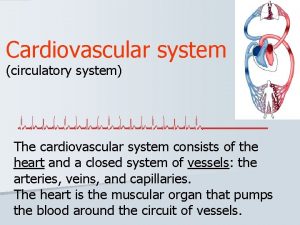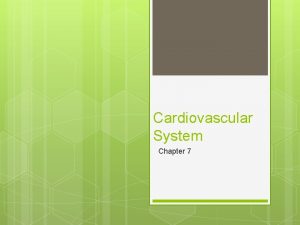The Cardiovascular System The cardiovascular system consists of







- Slides: 7

The Cardiovascular System The cardiovascular system consists of the heart, the blood vessels and blood. Its main aim is to deliver oxygen to the working muscles and remove waste products (such as carbon dioxide). This occurs in a double circulatory system – a circuit that connects the heart and lungs and the heart an the body. Deoxygenated blood is pumped from the heart to the lungs through the pulmonary artery. Lungs Deoxygenated blood returns to the heart through the vena cava. Muscles & organs Oxygenated blood returns to the heart through the pulmonary vein. Oxygenated blood is pumped at high pressure from the heart to the body through the aorta.

The Double Circulatory System The circulatory system is spilt into two circuits – the pulmonary system and the systemic system. The pulmonary system carries: • deoxygenated blood from the heart to the lungs • oxygenated blood back from the lungs to the heart, ready to be pumped out to the body. Muscles & organs Lungs The systemic system carries: • oxygenated blood to the rest of the body through the arteries • deoxygenated blood back to the heart through the veins.

Blood is surrounded by a liquid called plasma. Blood also consists of erythrocytes (red blood cells), leucocytes (white blood cells) and thrombocytes (platelets). Red blood cells are disc-shaped and made inside bone marrow. They contain a compound called haemoglobin, which bonds with oxygen to transport it around the body. The amount of haemoglobin in the blood can be increased during cardiovascular training. White blood cells act as the body's defence system. Some surround and consume harmful microbes whereas others produce antibodies that fight infections. Platelets are involved in helping the blood to clot when we get cuts and they harden to form scabs.

Blood Vessels Blood is transported around the body in three main blood vessels: 1. Arteries carry blood at a high pressure and often away from the heart. They have a thick outer wall and a narrow lumen (central tube). 2. Veins carry blood at a low pressure and return in back to the heart. Veins contain pocket valves that prevent the backflow of blood. They have a thin outer wall and a wide lumen. 3. Capillaries have only a single layer of cells in their walls. They are found around the muscles because they are thin enough for nutrients (oxygen) and waste products (carbon dioxide) to pass through them.

1. Superior Vena Cava Carries deoxygenated blood (blue) from the body to the heart. Heart Structure Flow of Deoxygenated Blood 2. Right Atrium Upper chamber on the right of the heart. It receives blood from the vena cava and pumps it into the right ventricle. 3. Tricuspid Valve between the right atrium and the right ventricle which stops backflow of blood. 4. Right Ventricle Lower chamber on the right of the heart. It receives deoxygenated blood from the right atrium 5. Pulmonary Semi-Lunar Valve Prevents backflow of blood from the arteries into the right ventricle. 6. Pulmonary Artery Carries deoxygenated blood (blue) from the heart to the lungs, where it collects oxygen. 1 6 5 2 3 4

1. Pulmonary Veins Carries oxygenated blood (red) from the lungs to the heart. Heart Structure Flow of Oxygenated Blood 2. Left Atrium Upper chamber on the left of the heart. It receives blood from the pulmonary vein and pumps it into the left ventricle. 3. Mitral Valve between the left atrium and the left ventricle which prevents backflow of blood. 4. Left Ventricle Lower chamber on the left of the heart. It receives oxygenated blood from the left atrium. 5. Aortic Semi-Lunar Valve Prevents backflow of blood from the aorta into the left ventricle. 6. Aorta Carries oxygenated blood (red) from the heart to the body, where it is used by the muscles. 6 5 1 2 3 4

Blood Vessels Blood is transported around the body in three main blood vessels: 1. Arteries carry blood at a high pressure and often away from the heart. They have a thick outer wall and a narrow lumen (central tube). 2. Veins carry blood at a low pressure and return in back to the heart. Veins contain pocket valves that prevent the backflow of blood. They have a thin outer wall and a wide lumen. 3. Capillaries have only a single layer of cells in their walls. They are found around the muscles because they are thin enough for nutrients (oxygen) and waste products (carbon dioxide) to pass through them.
 Arterial blood vs venous blood
Arterial blood vs venous blood What makes up the circulatory system
What makes up the circulatory system Pithed model
Pithed model Cardiovascular/lymphatic system it's totally tubular
Cardiovascular/lymphatic system it's totally tubular Structure of blood vessels
Structure of blood vessels Chapter 5 the cardiovascular system labeling exercises
Chapter 5 the cardiovascular system labeling exercises Chapter 11 the cardiovascular system figure 11-3
Chapter 11 the cardiovascular system figure 11-3 Figure 11-9 is a diagram of the hepatic portal circulation
Figure 11-9 is a diagram of the hepatic portal circulation













